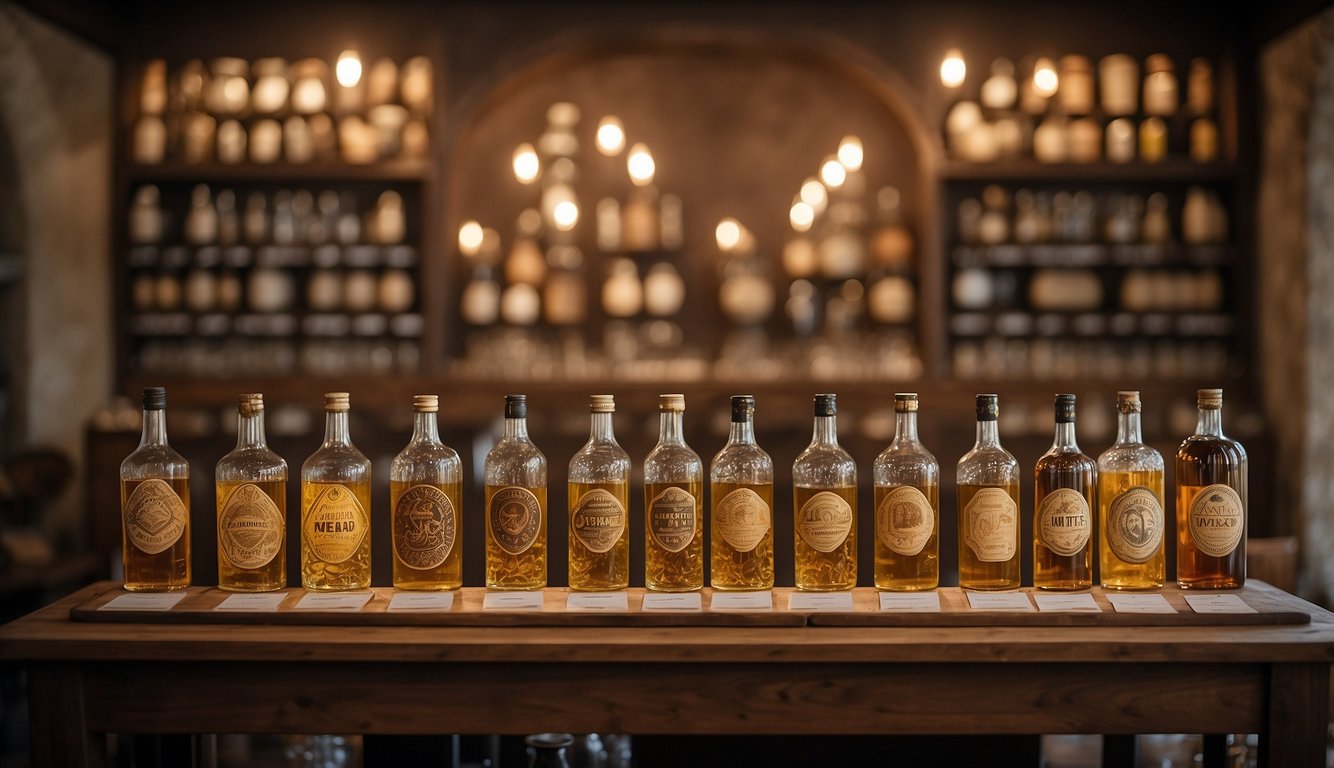Mead, a fermented honey drink, was an integral part of Viking culture. They believed that mead was a divine beverage created from the saliva of the gods, and its consumption was seen as a way to connect with the gods.
The Vikings had a deep appreciation for mead, and they used it in various rituals and ceremonies.

Drinking mead was a celebratory act, often associated with victories in battle or successful voyages, and was a way to honor the gods for their blessings. During Viking celebrations, mead was often served in special drinking vessels known as “mugs.” These mugs were typically made of precious metals and adorned with intricate designs. Mead was also an important part of Viking weddings, where the bride and groom shared mead in a ritual that symbolized their union.
The cultural significance of mead in Viking society is undeniable. It was not just a drink but a symbol of strength, glory, and divine connection. The Mead of the Gods was a path to greatness, and the Vikings used it to celebrate their victories and honor their gods.
Historical Roots of Mead in Norse Culture

The Mythological Origins
Mead, a fermented honey drink, has a long history in Norse mythology. According to legend, the gods themselves created mead. The story goes that the giant Suttung had stolen a magical mead that had been brewed by the gods. In order to retrieve the mead, Odin, the king of the gods, transformed himself into a serpent and slithered into the cave where the mead was being kept. Once inside, he seduced Suttung’s daughter, who then gave him three sips of the mead. Odin then transformed himself into an eagle and flew back to Asgard, the home of the gods, with the mead.
Mead in Viking Society
Mead was not only a drink enjoyed by the gods, but also by the Vikings themselves. It was a drink of celebration and ritual, and played a key role in feasts, gatherings, and marking significant events. Mead was also used as an offering to the gods in Norse rituals and sacrifices, with the hope of receiving blessings of eloquence and artistic ability.
In Viking culture, mead was a symbol of wealth and status. It was often served in elaborate drinking horns, which were decorated with intricate carvings and designs. The act of drinking mead was seen as a way to honor the gods and strengthen bonds between warriors.
Archaeological Discoveries
Archaeological evidence suggests that mead was a popular drink in Viking society. Excavations of Viking settlements have uncovered drinking horns, as well as pottery and other vessels used for storing and serving mead. The remains of honeycombs have also been found at some sites, indicating that mead was brewed locally.
Overall, mead played an important role in Norse culture, both in mythology and in everyday life. Its origins can be traced back to the gods themselves, and it was seen as a way to honor them and strengthen bonds between warriors. Archaeological evidence confirms that mead was a popular drink in Viking society, and its legacy continues to this day.
The Sacred and Social Role of Mead

Mead was more than just a beverage in Viking society. It played a central role in religious and social life, and its consumption was often accompanied by elaborate rituals and ceremonies. Here are some of the ways in which mead was viewed and used in Viking culture.
Rituals and Celebrations
Mead was an essential part of religious rituals and ceremonies in Viking culture. It was believed to have mystical powers, and its consumption was seen as a way to connect with the gods. During Viking celebrations, mead was often served in special drinking vessels known as “mugs,” which were typically made of horn or metal. These mugs were often decorated with intricate designs and symbols, and were sometimes passed around in a specific order to signify the hierarchy of the group.
Mead Halls and Social Gatherings
Mead halls were central to Viking social life, and were often used for feasts, celebrations, and other social gatherings. These halls were typically large, open spaces with a central fireplace, and were often decorated with tapestries and other ornamental objects. Mead was a common drink at these gatherings, and was often served in large drinking horns or other elaborate vessels.
Symbolism and Status
Mead was also a symbol of social status and celebration in Viking culture. It was often given as a gift to chieftains and other high-ranking members of society, and was sometimes used to seal alliances and other agreements. The quality of the mead served at a gathering was often seen as a reflection of the host’s wealth and status, and its consumption was sometimes accompanied by elaborate displays of generosity and hospitality.
In conclusion, mead played a central role in Viking culture, serving as a symbol of social status, celebration, and religious significance. Its consumption was often accompanied by elaborate rituals and ceremonies, and it was viewed as an essential part of social and religious life.
The Craft and Varieties of Mead

Mead is an alcoholic beverage made by fermenting honey with water, yeast, and sometimes grains, spices or fruit. It is one of the oldest alcoholic beverages in the world, and it has been enjoyed by people for thousands of years. In this section, we will explore the craft and varieties of mead.
Ingredients and Fermentation
The basic ingredients for making mead are honey, water, and yeast. The quality of the honey and water can affect the taste of the mead. Yeast is added to the mixture to ferment the honey and produce alcohol. Different strains of yeast can create different flavors and aromas. Mead can also be flavored with spices, grains or fruit.
Regional Flavors and Techniques
Different regions have their own unique flavors and techniques for making mead. For example, Nordic mead is often flavored with juniper berries and brewed with a high alcohol content. Polish mead, on the other hand, is often made with fruit and has a lower alcohol content. The techniques for making mead also vary by region, with some meads being aged for years in barrels to develop complex flavors.
Modern Mead-Making and Resurgence
In recent years, mead has experienced a resurgence in popularity, with many meaderies opening up around the world. Modern mead-makers are experimenting with new flavors and techniques, creating meads that are infused with everything from coffee to hops. Mead can be enjoyed on its own or used as a mixer in cocktails.
In conclusion, mead is a versatile and delicious beverage that has been enjoyed by people for thousands of years. With its wide variety of flavors and techniques, there is a mead for everyone to enjoy.
Mead in Lore and Legend

Tales of the Mead of Poetry
Mead has a long association with Norse mythology, where it is often referred to as the “Mead of Poetry.” According to legend, the Mead of Poetry was created when the god Kvasir was killed by two dwarves, who then mixed his blood with honey to create the magical beverage. The Mead of Poetry was said to have the power to bestow magical powers and immortality upon those who drank it.
The Mead of Poetry was also associated with Gunnlod, a giantess who guarded it in a cave. In one myth, the god Odin seduced Gunnlod and stole the Mead of Poetry from her, bringing it back to the realm of the gods. The Mead of Poetry was also said to have been hidden away by Suttungr, who stole it from the gods and hid it in a mountain. But Odin, with his newfound wisdom from Mimir’s well, was able to retrieve the Mead and bring it back to the realm of the gods.
Legendary Figures and Their Mead
Mead was often associated with legendary figures in Norse mythology. For example, Freyja, the goddess of love and fertility, was said to have a boar named Hildisvini who would provide her with an endless supply of Mead. Loki, the trickster god, was also known to have a fondness for Mead, and was said to have once caused trouble at a feast by killing a servant who was serving the Mead.
In addition to the gods, Mead was also associated with heroes and fallen warriors. In one myth, the hero Sigurd was said to have drunk Mead from the breasts of the goat Heidrun, which gave him magical powers and made him invincible in battle. Mead was also said to be the drink of choice for fallen warriors who were brought to Valhalla, where they would feast and drink Mead for eternity.
The legacy of Mead in Norse mythology is one of magic, power, and connection to the divine. Mead was seen as a way to gain wisdom, magical powers, and immortality, and was often associated with legendary figures and heroes. Even today, Mead remains an important part of Viking culture and is still enjoyed by many as a way to connect with the traditions and legends of the past.










Add Comment